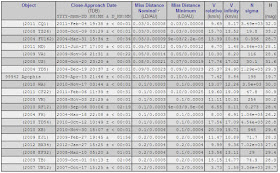Today, January 27, 2012 at about 15:25 UT, the asteroid designated 2012 BX34 will pass only 59,044 km (36,750 miles) or about ~0.2 lunar distance (or 0.0004 AU) above the Earth's surface. The asteroid was discovered by Catalina Sky Survey with a 0.68-m Schmidt + CCD on January 25, 2012 at magnitude ~20.
According to its absolute magnitude (H=27.6) this asteroid has an estimated diameter of roughly 8-18 meters, so it is very small. We have been able to follow-up this object few hours ago remotely from the GRAS Observatory (near Mayhill, NM) through a 0.10-m f/5 reflector + CCD.
According to its absolute magnitude (H=27.6) this asteroid has an estimated diameter of roughly 8-18 meters, so it is very small. We have been able to follow-up this object few hours ago remotely from the GRAS Observatory (near Mayhill, NM) through a 0.10-m f/5 reflector + CCD.
At the moment of our images from New Mexico on January 27, 11:04UT, "2012 BX34" was moving at about ~318.86 "/min and its magnitude was ~15. At the moment of its close approach around 15UT of today, 2012 BX34 will be bright as magnitude ~13.8 and moving at ~1810 "/min.
Below you can see a single 120-seconds exposure showing the object as a ~11-arcminutes trail (due to its fast speed). Click on the thumbnail to see a bigger version:
Below you can see a single 120-seconds exposure showing the object as a ~11-arcminutes trail (due to its fast speed). Click on the thumbnail to see a bigger version:
While this is an animation showing the object moving among the field stars. Each image was a 120-second exposure. Click on the thumbnail to see a bigger version:
While there is no cause for concern, this is one of the closest approaches recorded. The table below shows the top 20 closest approaches by NEOs (Near-Earth Objects) sorted by nominal distance. The table has been computed on the NASA/Neo-JPL website (the event that took 2008 TC3 into the earth's atmosphere is not included). Click on the thumbnail to see a bigger version:
by Ernesto Guido, Giovanni Sostero & Nick Howes











